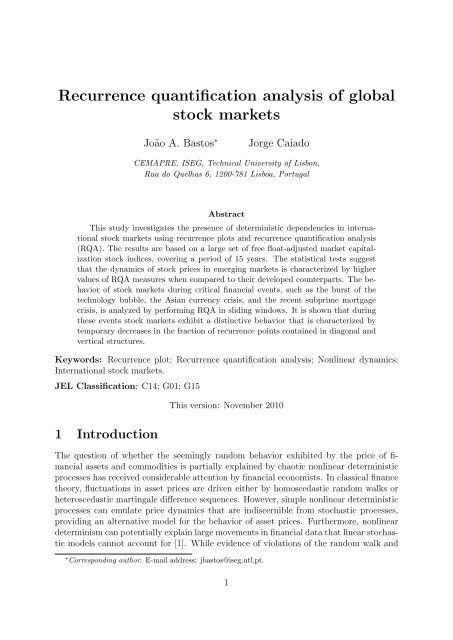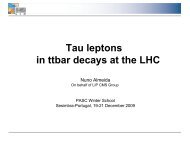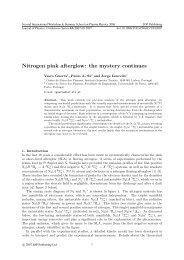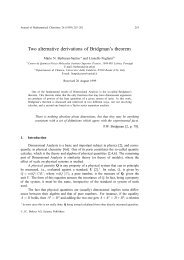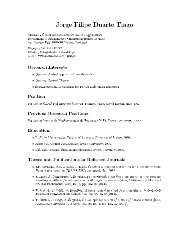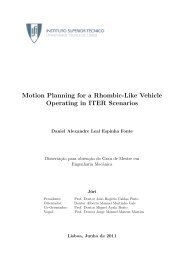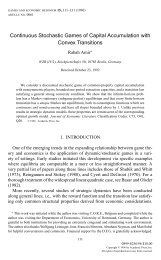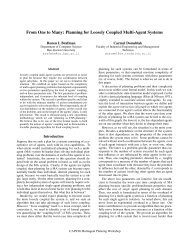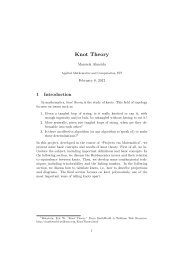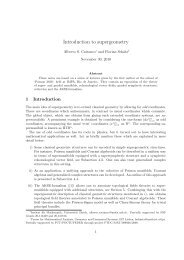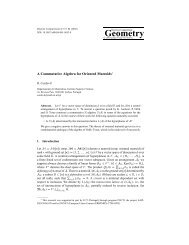Recurrence quantification analysis of global stock markets - Cemapre
Recurrence quantification analysis of global stock markets - Cemapre
Recurrence quantification analysis of global stock markets - Cemapre
- No tags were found...
You also want an ePaper? Increase the reach of your titles
YUMPU automatically turns print PDFs into web optimized ePapers that Google loves.
improves the interpretation <strong>of</strong> these structures and their relationship with the evolution<strong>of</strong> the <strong>stock</strong> indices.Figure 2: Distance plots for three Southeast Asian <strong>stock</strong> <strong>markets</strong>: Indonesia (left),Malaysia (center) and Thailand (right), in the period 01:1995-12:2009. Parameters: embeddingdimension m = 11, delay τ = 1.Figure 2 presents distance plots for three emerging <strong>markets</strong> in Southeast Asia: Indonesia,Malaysia and Thailand. These neighboring economies also share many commonfeatures. However, the patterns are structurally different from those exhibited by theWestern <strong>markets</strong> in Figure 1. These examples suggest that <strong>stock</strong> <strong>markets</strong> in countrieswith strong economic interdependence tend to display similar features in recurrence plots.The plots for Indonesia, Malaysia and Thailand are also more structured than those inFigure 1. Instead <strong>of</strong> a “butterfly” shaped structure, these plots display an “arrow” shapedstructure. On the other hand, in conformity with the Western <strong>markets</strong>, long vertical andhorizontal light shaded bands are also observed in the rightmost and upper regions <strong>of</strong> theplot, respectively.Figure 3: Distance plots for three East European <strong>stock</strong> <strong>markets</strong>: Czech Republic (left),Poland (center) and Russia (right), in the period 01:1995-12:2009. Parameters: embeddingdimension m = 11, delay τ = 1.Figure 3 displays distance plots for three <strong>stock</strong> <strong>markets</strong> in Eastern Europe: CzechRepublic, Poland and Russia. Again, these neighboring economies exhibit distinct patternsfrom those analyzed above. In particular, these <strong>markets</strong> are characterized by small6
distances in the lower left quadrant <strong>of</strong> the plot, and increasing distances towards theupper right corner. This suggests that these indices underwent a notable evolution in theperiod covered by the data. Interestingly, the market <strong>of</strong> Russia also displays a smaller“butterfly” shaped structure in the lower left corner <strong>of</strong> the plot. The position <strong>of</strong> thisstructure suggests that it may be related to the sharp decline in asset prices that initiatedin late 1997. Again, vertical and horizontal light shaded bands can be discerned inthe rightmost and upper regions <strong>of</strong> the plot.Figure 4: Distance plots for three <strong>stock</strong> <strong>markets</strong> in Latin America: Argentina (left),Brazil (center) and Chile (right), in the period 01:1995-12:2009. Parameters: embeddingdimension m = 11, delay τ = 1.A similar evolution can be observed in the Latin American <strong>stock</strong> <strong>markets</strong> <strong>of</strong> Argentina,Brazil and Chile, as shown in Figure 4. These <strong>markets</strong> also present small distances inthe lower left section <strong>of</strong> the plot and larger distances towards the upper right corner. Inconformity with the previously analyzed <strong>markets</strong>, one can observe light shaded bands inthe rightmost and upper regions <strong>of</strong> the plot.4 <strong>Recurrence</strong> <strong>quantification</strong> <strong>analysis</strong> <strong>of</strong> <strong>stock</strong> <strong>markets</strong>While the visual inspection <strong>of</strong> recurrence or distance plots provides interesting insights,their interpretation if <strong>of</strong>ten difficult and subjective. <strong>Recurrence</strong> <strong>quantification</strong> <strong>analysis</strong>[8, 9, 10] introduces numerical measures that allow for the <strong>quantification</strong> <strong>of</strong> the structureand complexity <strong>of</strong> RPs. These quantities are based on recurrence point densities, anddiagonal and vertical segments. Several measures have been proposed in the literature,and the following are considered here [11]:• REC: fraction <strong>of</strong> recurrence points in the recurrence plot. This measure estimatesthe probability that a certain state recurs.• DET: fraction <strong>of</strong> recurrence points forming diagonal lines. This measure providesan indication <strong>of</strong> determinism and predictability in the system.7
• LMAX: length <strong>of</strong> the longest diagonal line, excluding the line <strong>of</strong> identity. Theinverse <strong>of</strong> this measure is related to the exponential divergence <strong>of</strong> the phase-spacetrajectory.• ENTR: Shannon entropy <strong>of</strong> the distribution <strong>of</strong> lengths <strong>of</strong> diagonal lines. Thismeasure provides information about the diversity <strong>of</strong> diagonal lines in the plot.• LAM: fraction <strong>of</strong> recurrence points forming vertical lines. This measure is sensitiveto the occurrence <strong>of</strong> laminar states in the system.• TT: average length <strong>of</strong> vertical lines. This measure estimates the mean time thatthe system remains at a specific state (“trapping time”).In Figure 5, the dark circles show the RQA variables computed for the 46 <strong>stock</strong> indicesin the data set. The vertical ticks represent 95% confidence intervals that were estimatedusing bootstrapped pseudo samples <strong>of</strong> the distributions <strong>of</strong> diagonal and vertical lines, assuggested in Ref. [26]. Of course, the computation <strong>of</strong> confidence intervals is restricted toRQA measures obtained from distributions <strong>of</strong> diagonal and vertical lines, namely DET,ENTR, LAM and TT. The <strong>markets</strong> in each group were ordered by increasing values <strong>of</strong>the RQA variables. It should be noted that, over long periods, financial <strong>markets</strong> gothrough several structural and behavioral changes. During the period covered by thedata, several events affected <strong>stock</strong> <strong>markets</strong> around the world, ranging from technologyand real estate bubbles to the deepest financial crisis since the Great Depression <strong>of</strong> the1930s. Moreover, these events had different repercussions across economic regions. Forinstance, Southeast Asian <strong>stock</strong> <strong>markets</strong> were almost unaffected by the burst <strong>of</strong> the dotcombubble in 2000, while their Western counterparts underwent a bearish period thatlasted several years. Therefore, the values in Figure 5 merely provide a <strong>global</strong> perspective<strong>of</strong> the market dynamics in the 15 years covered by the data. In fact, the time-dependent<strong>analysis</strong> <strong>of</strong> RQA measures that is presented in Section 5, shows that these variables canvary substantially in different epochs.The two leftmost plots on top <strong>of</strong> Figure 5 show the values <strong>of</strong> REC for developed andemerging <strong>stock</strong> <strong>markets</strong>. One can observe that developed <strong>markets</strong> generally exhibit lowervalues <strong>of</strong> REC with respect to their emerging counterparts. In the group <strong>of</strong> developed<strong>markets</strong> group, those <strong>of</strong> Austria, Norway and Australia standout as having substantiallylarger values <strong>of</strong> REC. In the group <strong>of</strong> emerging <strong>markets</strong>, the <strong>stock</strong> market <strong>of</strong> the CzechRepublic exhibits the highest value <strong>of</strong> REC, in conformity with the large light shadedarea on the corresponding distance plot that is shown in Figure 3.The first row on Figure 5 also shows the values <strong>of</strong> DET. This measure may be interpretedas a signature <strong>of</strong> determinism in the price generating process. Yet, it shouldbe noted that high values <strong>of</strong> DET do not guarantee that the dynamics <strong>of</strong> the indicesmay be explained by deterministic processes. As exemplified in Ref. [28], a stochasticthird-order autoregressive process may have a DET value as large as 0.6. Nevertheless,the values <strong>of</strong> DET in developed <strong>markets</strong> are generally smaller than those in emerging<strong>markets</strong>, which may be related to the fact that <strong>stock</strong> returns in developed <strong>markets</strong> arenormally less predictable than those in emerging <strong>markets</strong>, given the lower amount <strong>of</strong>market and regulatory “frictions”, and the greater access to high quality informationin developed economies. Furthermore, empirical studies suggest that the random walk8
hypothesis is more frequently violated in emerging <strong>markets</strong> than in developed <strong>markets</strong>(see, e.g., Ref. [29]).One should note that, because the confidence intervals <strong>of</strong> DET are large and overlapconsiderably, it is difficult to reach any strong conclusions with respect to the relativepositioning <strong>of</strong> the <strong>markets</strong>. Despite that, the two <strong>markets</strong> with largest capitalizationin the world, Japan and the United States, exhibit the first and third lowest values <strong>of</strong>DET in their group. Other large European <strong>stock</strong> <strong>markets</strong>, such as France, Italy, theNetherlands, and the United Kingdom also have relatively low values <strong>of</strong> DET. On theother hand, in the emerging <strong>markets</strong> group, the market <strong>of</strong> Taiwan clearly stands out,exhibiting a value <strong>of</strong> DET that is well below those <strong>of</strong> most developed <strong>markets</strong>. This isno surprise since Taiwan’s Stock Exchange has the 9th highest liquidity and 13th largestvalue <strong>of</strong> share trading in the world. 4The measure LMAX is shown in the middle <strong>of</strong> Figure 5. One may observe that thismeasure is not particularly informative. Most <strong>markets</strong> have a value LMAX=3903, whichcorresponds to the length <strong>of</strong> the diagonal line adjacent to the LoI. The <strong>stock</strong> market <strong>of</strong>Finland stands out as having the lowest value <strong>of</strong> LMAX among the 46 <strong>markets</strong>. Themiddle row <strong>of</strong> Figure 5 also shows the measure ENTR. The values <strong>of</strong> ENTR should besmaller for uncorrelated time series with low predictability. Developed <strong>stock</strong> <strong>markets</strong>typically exhibit lower values <strong>of</strong> ENTR with respect to their emerging counterparts. Furthermore,the relative order <strong>of</strong> <strong>stock</strong> <strong>markets</strong> in terms <strong>of</strong> DET values is almost replicatedin terms <strong>of</strong> ENTR values. The <strong>stock</strong> <strong>markets</strong> <strong>of</strong> Japan and the United States feature thelowest values <strong>of</strong> ENTR among the developed <strong>markets</strong> group. In the emerging <strong>markets</strong>group, the <strong>stock</strong> market <strong>of</strong> Taiwan stands out again as having the lowest value <strong>of</strong> ENTR.Finally, the bottom <strong>of</strong> Figure 5 displays the RQA measures based on vertical structures:LAM and TT. Again, the relative order <strong>of</strong> <strong>stock</strong> <strong>markets</strong> according to these measures isvery similar to the relative order given by other measures.Table 1 reports the means (m d and m e ), medians (me d and me e ) and standard deviations(σ d and σ e ) <strong>of</strong> the observed RQA measures for developed and emerging <strong>markets</strong>.As anticipated, the mean and median values for emerging <strong>markets</strong> are larger than thosefor developed <strong>markets</strong>. The two-group mean comparison T -test and the nonparametricWilcoxon-Mann-Whitney U-test for testing the null hypothesis <strong>of</strong> equal population mediansare also shown. In both tests, the p-values indicate that the differences in REC,DET, ENTR, LAM and TT between developed and emerging <strong>markets</strong> are statisticallysignificant at 5% level. On the other hand, the mean and median LMAX in developedand emerging <strong>markets</strong> are not statistically different at the conventional levels.Box plots comparing the observed RQA measures in developed and emerging <strong>markets</strong>are shown in Figure 6. These plots are consistent with the results <strong>of</strong> the mediancomparison test. The distributions <strong>of</strong> ENTR, TT, DET for developed <strong>markets</strong>, and RECfor emerging <strong>markets</strong> are rather skewed. Note that with respect to measure LMAX, theabsence <strong>of</strong> a box for the group <strong>of</strong> emerging <strong>markets</strong> indicates that the interquartile range(i.e, the difference between the 75th percentile and the 25th percentile) is zero. The boxplots also make clear the presence <strong>of</strong> outliers in the data, represented by dark circles.With respect to measure REC, three outliers can be identified with values above themedian: Australia, Austria and Norway. The box plots for DET and LAM exhibit one4 Source: http://www.world-exchanges.org/statistics (January 2010).10
REC DET LMAX ENTR LAM TTm d 0.145 0.991 3697 4.527 0.993 64.45me d 0.130 0.991 3903 4.437 0.994 52.17σ d 0.050 0.005 336 0.389 0.005 30.98m e 0.189 0.994 3817 4.849 0.996 103.68me e 0.167 0.995 3903 4.732 0.997 71.98σ e 0.061 0.004 181 0.456 0.003 80.34T -test -2.682 -2.194 -1.509 -2.575 -2.248 -2.185p-value 0.010 0.034 0.138 0.014 0.030 0.034U-test -3.306 -2.505 -1.531 -2.735 -2.571 -2.669p-value 0.001 0.012 0.126 0.006 0.010 0.008Without outliersT -test -4.396 -2.950 -3.117 -2.575 -3.119 -3.013p-value 0.000 0.055 0.004 0.014 0.003 0.003U-test -4.212 -2.665 -3.013 -2.735 -2.736 -3.224p-value 0.000 0.008 0.003 0.006 0.006 0.001Table 1: Mean, median and standard deviation <strong>of</strong> the observed RQA measures for developedand emerging <strong>markets</strong>; two-sample T -tests for the null hypothesis <strong>of</strong> equal means;and two-sample Wilcoxon-Mann-Whitney U-tests for the null hypothesis <strong>of</strong> equal medians.The bottom panel shows the T -tests and U- tests when outliers are removed.outlier in each group with values lower than the respective group median: Japan andTaiwan. The variable LMAX shows one outlier in the developed <strong>markets</strong> group (Finland)and five outliers in the emerging <strong>markets</strong> group (Chile, China, Czech Republic,Hungary and Mexico). With respect to the measure TT, five outliers with values abovethe median can be identified: three in the developed <strong>markets</strong> group (Australia, Austriaand Norway) and one in the emerging <strong>markets</strong> group (Czech Republic). ENTR showsno outliers. The bottom panel <strong>of</strong> Table 1 shows the two-group mean comparison T -testand the Wilcoxon-Mann-Whitney U-test recomputed without the identified outliers. Onecan observe that after the removal <strong>of</strong> outliers (Japan and Taiwan) the difference in meanDET in no longer statistically significant at the conventional 5% level.5 Moving window RQAThe RQA measures reported above provide a <strong>global</strong> picture <strong>of</strong> the behavior <strong>of</strong> <strong>stock</strong><strong>markets</strong> during the entire period covered by the data. However, it is plausible that theunderlying market dynamics changes when long periods are examined. Therefore, it isimportant to understand the evolution <strong>of</strong> these variables as a function <strong>of</strong> time and, inparticular, their behavior during the critical financial events covered by the data. In orderto study the temporal evolution <strong>of</strong> RQA measures and detect transient dynamics in the<strong>stock</strong> indices, a “windowed” version <strong>of</strong> RQA [30] is conducted. In this approach, RQAvariables are computed for successive windows spanning the time series. These windows11
REC.1 .15 .2 .25 .3 .35DET.97 .98 .99 1LMAX2,500 3,000 3,500 4,000DevelopedEmergingDevelopedEmergingDevelopedEmergingENT3.5 4 4.5 5 5.5LAM.975 .98 .985 .99 .995 1TT0 100 200 300 400DevelopedEmergingDevelopedEmergingDevelopedEmergingFigure 6: Box plots <strong>of</strong> RQA measures for developed and emerging <strong>markets</strong>. The bottomand top <strong>of</strong> the boxes are the first and third quartiles and the band near the middle is themedian. The ends <strong>of</strong> the vertical lines represent the minimum and maximum observations,unless outliers are identified in which case the vertical lines extend to the upper/lowerobservations adjacent to the outliers. Outliers are represented by dots.correspond to smaller RPs sliding along the main diagonal line <strong>of</strong> the RP constructedwith the full data. The length <strong>of</strong> the sliding window represents a compromise betweenresolving small-scale local fluctuations and detecting recurrence structures located fartheraway from the LoI. Because critical financial events typically span periods ranging fromseveral months to a few years, a sliding window with length <strong>of</strong> 260 observations is chosen,corresponding to about one year <strong>of</strong> trading days. A preliminary <strong>analysis</strong> shows that theRQA measures DET and LAM are the most sensitive to critical financial events.In the past 15 years, the most notable <strong>stock</strong> market events were the burst <strong>of</strong> thespeculative technology (or dot-com) bubble, the subprime mortgage crisis, and the Asiancurrency crisis. 5 The top panel <strong>of</strong> Figure 7 shows the evolution <strong>of</strong> the MSCI indices for5 The technology bubble was the result <strong>of</strong> the Internet age “new economy” euphoria, when many ITcompanies were traded at historically high price-earnings ratios driven by unrealistic expectations <strong>of</strong>large future earnings. In March 2000, <strong>stock</strong> <strong>markets</strong> across industrialized nations plummeted, initiatinga bearish trend that persisted for almost three years. The subprime mortgage crisis <strong>of</strong> 2008-2009 wasoriginated by an enormous increase in mortgage defaults and foreclosures in the United States. Thereal estate crisis quickly spread to the banking and financial system through securities tied to mortgagepayments and real estate prices, precipitating the most severe economic downturn since the Great Depression<strong>of</strong> the 1930s. The Asian currency crisis was a deep financial crisis that affected several economiesfrom the Pacific Rim in mid-1997. The crisis was triggered by the collapse <strong>of</strong> the Thai baht, after thegovernment decision to abandon the fixed exchange rate regime against the USD. This event destabilizedthe currencies <strong>of</strong> neighboring countries, namely Hong Kong, Indonesia, Malaysia, Philippines and SouthKorea. The subsequent financial turmoil had a tremendous impact on <strong>stock</strong>s and other assets.12
Price500 1000 1500 2000 2500GER UK US96 97 98 99 00 01 02 03 04 05 06 07 08 09 10DETLAMGER.85 .9 .95 1UK.8 .85 .9 .95 196 98 00 02 04 06 08 10DETGER.9 .92 .94 .96 .98 1UK.8 .85 .9 .95 196 98 00 02 04 06 08 10LAM96 98 00 02 04 06 08 10DET96 98 00 02 04 06 08 10LAMUS.9 .92 .94 .96 .98 1US.9 .92 .94 .96 .98 196 98 00 02 04 06 08 1096 98 00 02 04 06 08 10Figure 7: Evolution <strong>of</strong> the MSCI indices (top panel), DET (left plots) and LAM (rightplots) for the <strong>stock</strong> <strong>markets</strong> <strong>of</strong> Germany, United Kingdom and United States. The graybands represent 95% confidence intervals. Parameters: embedding dimension m = 11,delay τ = 1, recurrence threshold ε = 0.16.13
the three largest <strong>stock</strong> <strong>markets</strong> in the Western world: Germany, the United Kingdomand the United States. Large declines in <strong>stock</strong> values are observed during the burst <strong>of</strong>the technology bubble. In fact, from March 2000 to three years later, the MSCI indicesfor Germany, the United Kingdom and the United States experienced cumulative losses<strong>of</strong> 64%, 41% and 43%, respectively. The collapse <strong>of</strong> <strong>stock</strong> values during the subprimemortgage crisis was even more abrupt and severe. From the peaks in late 2007 to theminima reached in March 2009, the indices for Germany, the United Kingdom and theUnited States lost 64%, 65% and 56% <strong>of</strong> their values, respectively. A relatively smallercrash can be observed in August 1998, as a result <strong>of</strong> Russia default on its sovereign debtand the LTCM hedge fund bailout. The top panel <strong>of</strong> Figure 8, shows the evolution <strong>of</strong>the MSCI indices <strong>of</strong> Indonesia, Malaysia and Thailand. One can notice that the <strong>stock</strong>market <strong>of</strong> Thailand began a downward trend in mid-1996, well before the height <strong>of</strong> thecurrency crisis, while the collapse <strong>of</strong> the <strong>markets</strong> <strong>of</strong> Indonesia and Malaysia was initiatedwith the onset <strong>of</strong> the crisis. The MSCI indices suffered enormous losses <strong>of</strong> almost 90%during the period <strong>of</strong> one year. These indices also experienced tremendous declines as aresult <strong>of</strong> the subprime mortgage crisis.In Figures 7 and 8, the leftmost and rightmost plots show the evolution <strong>of</strong> the RQAvariables DET and LAM, respectively. The 95% confidence intervals for these variablesare represented by gray bands. The date on the horizontal axis corresponds to the last dayin the window. In Figures 7 and 8, one can note that during long periods DET and LAMare rather stable and close to one, indicating that most recurrence points are containedin diagonal and vertical structures, respectively. Two distinct periods, characterized byslumps in the levels <strong>of</strong> DET and LAM, can be identified in Figure 7. These periodsroughly coincide with the burst <strong>of</strong> the technology bubble and the subprime mortgagecrisis. The burst <strong>of</strong> the technology bubble resulted in declines in DET and LAM <strong>of</strong> afew percent. In the <strong>markets</strong> <strong>of</strong> Germany and the United Kingdom, DET and LAM onlystabilize near unity in mid-2003, when the <strong>global</strong> recovery period begins. In the market<strong>of</strong> the United States, they only stabilize in mid-2004. The reductions in DET and LAMduring the subprime mortgage crisis are larger than the reductions during the burst <strong>of</strong>the technology bubble. During this event, one can observe reductions <strong>of</strong> about 5% inthe <strong>stock</strong> <strong>markets</strong> <strong>of</strong> Germany and United States and about 10% in the market <strong>of</strong> theUnited Kingdom. Interestingly, the evolution <strong>of</strong> these measures across the three <strong>markets</strong>appears to be more synchronized in the subprime mortgage crisis than in the burst <strong>of</strong>the technology bubble. A remarkable feature <strong>of</strong> the evolution <strong>of</strong> DET and LAM is thatthe declines appear to precede both crashes by several months. This behavior was alsoreported in the <strong>analysis</strong> <strong>of</strong> the dot-com bubble performed in Ref. [15] and [22]. In thesestudies, DET and LAM took the highest values during the bullish period and declinedmonths before the bubble burst.In Figure 8, DET and LAM are relatively stable and close to unity between the end <strong>of</strong>the Asian currency crisis and the <strong>global</strong> economic downturn <strong>of</strong> 2008−2009. In the market<strong>of</strong> Thailand, these variables exhibit large fluctuation since the beginning <strong>of</strong> the data set,well before the peak <strong>of</strong> the currency crisis. As a result <strong>of</strong> this crisis, large declines inthe levels <strong>of</strong> DET and LAM can be observed in the <strong>markets</strong> <strong>of</strong> Indonesia and Malaysia.Substantial decreases are also observed during the recession <strong>of</strong> 2008−2009. Also <strong>of</strong> note isthat DET and LAM were not particularly affected by the burst <strong>of</strong> the technology bubble.This is no surprise since these economies held up relatively well between 2000 and 2003.14
Price0 200 400 600 800INDO MAL THA96 97 98 99 00 01 02 03 04 05 06 07 08 09 10DETLAMINDO.85 .9 .95 1MAL.85 .9 .95 1THA.95 .96 .97 .98 .99 196 98 00 02 04 06 08 10DET96 98 00 02 04 06 08 10DET96 98 00 02 04 06 08 10INDO.85 .9 .95 1MAL.85 .9 .95 1THA.97 .98 .99 196 98 00 02 04 06 08 10LAM96 98 00 02 04 06 08 10LAM96 98 00 02 04 06 08 10Figure 8: Evolution <strong>of</strong> the MSCI indices (top panel), DET (left plots) and LAM (rightplots) for the <strong>stock</strong> <strong>markets</strong> <strong>of</strong> Indonesia, Malaysia and Thailand. The gray bands represent95% confidence intervals. Parameters: embedding dimension m = 11, delay τ = 1,recurrence threshold ε = 0.1615
6 ConclusionsIn this study, a comprehensive investigation <strong>of</strong> the dynamics <strong>of</strong> 46 <strong>stock</strong> <strong>markets</strong> wasperformed using recurrence plots and recurrence <strong>quantification</strong> <strong>analysis</strong>. The <strong>analysis</strong>covered the period between January 1995 and December 2009. Distance plots <strong>of</strong> several<strong>stock</strong> <strong>markets</strong> were presented. The analyzed plots suggest that <strong>stock</strong> <strong>markets</strong> in countrieswith strong economic interdependence tend to display similar features in recurrence plots.For instance, while distance plots <strong>of</strong> Western <strong>markets</strong> exhibited a “butterfly” shapedstructure, Southeast Asian market displayed an “arrow” shaped structure. On the otherhand, the plots for Eastern European and Latin American <strong>markets</strong> are characterized bysmall distances in the lower left corner <strong>of</strong> the plot and larger distances towards the upperright corner.Several RQA measures and corresponding 95% confidence intervals were computedfor the complete period. With respect to measure DET, which provides an indication <strong>of</strong>determinism in the price-generating system, the two largest <strong>markets</strong> in the world, Japanand the United States, exhibited the first and third lowest values, respectively. Otherlarge European <strong>stock</strong> <strong>markets</strong>, such as France, Italy, the Netherlands, and the UnitedKingdom also showed relatively low values <strong>of</strong> DET. However, the confidence intervals<strong>of</strong> the RQA measures are large and prudence is needed when interpreting the relativeorder <strong>of</strong> the <strong>markets</strong>. In the emerging <strong>markets</strong> group, the <strong>stock</strong> market <strong>of</strong> Taiwan clearlyoutstands has having the lowest values <strong>of</strong> DET.The measure ENTR provided similar results to those <strong>of</strong> measure DET. In the group<strong>of</strong> developed <strong>markets</strong>, Japan and the United States exhibited the lowest values <strong>of</strong> ENTR,while in the group <strong>of</strong> emerging <strong>markets</strong> Taiwan presented the lowest ENTR. In fact,the value <strong>of</strong> ENTR for Taiwan is smaller that those <strong>of</strong> many developed <strong>markets</strong>. Furthermore,the results provided by measures based on vertical structures, LAM and TT,essentially replicated those <strong>of</strong> measures based on diagonal structures. Two-group meancomparison T -tests and median comparison Wilcoxon-Mann-Whitney U-tests indicatedthat the differences between developed and emerging <strong>markets</strong> in terms <strong>of</strong> RQA measuresare statistically significant. These results substantiate the notion that the dynamics <strong>of</strong><strong>stock</strong> <strong>markets</strong> with large trading volumes and liquidity, and fewer problems <strong>of</strong> informationasymmetry and opaqueness, are normally less predictable.A time-dependent RQA was performed, focusing on the behavior <strong>of</strong> <strong>stock</strong> <strong>markets</strong>during <strong>stock</strong> market collapses, such as the burst <strong>of</strong> the technology bubble, the Asiancurrency crisis and the subprime mortgage crisis. This <strong>analysis</strong> showed that measuresDET and LAM can vary substantially over long periods <strong>of</strong> time. In particular, duringthese critical events significant declines in the levels <strong>of</strong> DET and LAM are observed.References[1] Hsieh, D.A., 1991. Chaos and nonlinear dynamics: Application to financial <strong>markets</strong>.The Journal <strong>of</strong> Finance 46, 1839-1877.[2] Lo, A.W., MacKinlay, A.C., 1988. Stock market prices do not follow random walks:Evidence from a simple specification test. The Review <strong>of</strong> Financial Studies 1, 41-66.16
[3] Fama, E.F., French, K.R., 1988. Permanent and temporary components <strong>of</strong> <strong>stock</strong>prices. The Journal <strong>of</strong> Political Economy 96, 246-273.[4] Potterba, J.M., Summers, L.H., 1988. Mean reversion in <strong>stock</strong> prices. Journal <strong>of</strong>Financial Economics 22, 27-59.[5] Barnett, W.A., Serletis, A., 2000. Martingales, nonlinearity, and chaos. Journal <strong>of</strong>Economic Dynamics & Control 24, 703-724.[6] Abhyankar, A., Copeland, L.S., Wong, W., 1997. Uncovering Nonlinear Structure inReal-Time Stock-Market Indexes: The S&P 500, the DAX, the Nikkei 225, and theFTSE-100. Journal <strong>of</strong> Business and Economic Statistics 15, 1-14.[7] Eckmann, J.-P, Kamphorst, A.O., Ruelle, D., 1987. <strong>Recurrence</strong> plots <strong>of</strong> dynamicalsystems. Europhysics Letters 5, 973-977.[8] Zbilut, J.P., Webber Jr., C.L., 1992. Embeddings and delays as derived from <strong>quantification</strong><strong>of</strong> recurrence plots. Physics Letters A 171, 199-203.[9] Webber Jr., C.L., Zbilut, J.P., 1994. Dynamical assessment <strong>of</strong> physiological systemsand states using recurrence plot strategies. Journal <strong>of</strong> Applied Physiology 76, 965-973.[10] Marwan, N., Wessel, N., Meyerfeldt, U., Schirdewan, A., Kurths, J., 2002.<strong>Recurrence</strong>-plot-based measures <strong>of</strong> complexity and its application to heart-rate variability.Physical Review E 66, 026702.[11] Marwan, N., Romano, M.C., Thiel, M., Kurths, J., 2007. <strong>Recurrence</strong> plots for the<strong>analysis</strong> <strong>of</strong> complex systems. Physics Reports 438, 237-329.[12] Webber Jr., C.L., Zbilut, J.P., 1998. Recurrent structuring <strong>of</strong> dynamical and spatialsystems. In: Colosimo, A. (Ed.). Complexity in the Living: A Modelistic Approach,101-133.[13] Holyst, J.A., Zebrowska, M., Urbanowicz, K., 2001. Observation <strong>of</strong> deterministicchaos in financial time series by recurrence plots, can one control chaotic economy?European Physical Journal B 20, 531-535.[14] Zbilut, J.P., 2005. Use <strong>of</strong> recurrence <strong>quantification</strong> <strong>analysis</strong> in economic time series.In: Salzano, M., Kirman, A., (Eds.). Economics: Complex Windows, 91-104.[15] Fabretti, A., Ausloos, M., 2005. <strong>Recurrence</strong> plot and recurrence <strong>quantification</strong> <strong>analysis</strong>for detecting a critical regime. Examples from financial market indices. InternationalJournal <strong>of</strong> Modern Physics 16, 671-706.[16] Kyrtsou, C., Vorlow, C.E., 2005. Complex dynamics in macroeconomics: A novelapproach. In: Diebolt, C., Kyrtsou, C. (Eds.). New Trends in Macroeconomics, 223-238.17
[17] Aparicio, T., Pozo, E. F., Saura, D., 2008. Detecting determinism using recurrence<strong>quantification</strong> <strong>analysis</strong>: Three test procedures. Journal <strong>of</strong> Economic Behavior &Organization 65, 768-787.[18] Belaire-Franch, J., Contreras, D., Tordera-Lledo, L., 2002. Assessing nonlinear structuresin real exchange rates using recurrence plot strategies. Physica D 171, 249-264.[19] Strozzi, F., Zaldivar, J.-M., Zbilut, J.P., 2002. Application <strong>of</strong> nonlinear time series<strong>analysis</strong> techniques to high-frequency currency exchange data. Physica A 312, 520-538.[20] Strozzi, F., Zaldivar, J.-M., Zbilut, J.P., 2007. <strong>Recurrence</strong> <strong>quantification</strong> <strong>analysis</strong>and state space divergence reconstruction for financial time series <strong>analysis</strong>. PhysicaA 376, 487-499.[21] Strozzi, F., Gutiérrez, E., Noè, C., Rossi, T., Serati, M., Zaldívar, J.M., 2008. Measuringvolatility in the Nordic spot electricity market using recurrence <strong>quantification</strong><strong>analysis</strong>. The European Physical Journal - Special Topics 164, 105-115.[22] Guhathakurta, K., Bhattacharya, B.; Chowdhury, A.R., 2010. Using recurrence plot<strong>analysis</strong> to distinguish between endogenous and exogenous <strong>stock</strong> market crashes.Physica A 389, 1874-1882.[23] Takens, F., 1981. Detecting strange attractors in turbulence. In: Rand, D., Young,L. (Eds.), Dynamical Systems and Turbulence, Springer, Berlin, 366381.[24] Cao, L., 1997. Pratical methods for determining the minimum embedding dimension<strong>of</strong> a scalar time series. Physica D 110, 43-50.[25] Schinkel, S., Dimigen, O., Marwan, N., 2008. Selection <strong>of</strong> recurrence threshold forsignal detection. European Physical Journal Special Topics 164, 45-53.[26] Schinkel, S., Marwan, N., Dimigen, O., Kurths, J., 2009. Confidence bounds <strong>of</strong>recurrence-based complexity measured. Physics Letters A, 2245-2250.[27] Iwanski, J., Bradley, E., 1998. <strong>Recurrence</strong> plot <strong>analysis</strong>: To embed or not to embed?Chaos 8, 861-871.[28] Marwan, N., 2010. How to avoid potential pitfalls in recurrence plot based data<strong>analysis</strong>. International Journal <strong>of</strong> Bifurcation and Chaos (in press).[29] Bastos, J.A., Caiado, J., 2009 Clustering <strong>global</strong> equity <strong>markets</strong> with variance ratiotests. CEMAPRE Working paper 0904.[30] Trulla, L.L., Giuliani, A., Zbilut, J.P., Webber Jr., C.L., 1996. <strong>Recurrence</strong> <strong>quantification</strong><strong>analysis</strong> <strong>of</strong> the logistic equation with transients. Physics Letters A 223,255-260.18


